GSP Belgrade

GSP Belgrade

Native name | ГСП Београд |
|---|---|
Type | State-owned enterprise |
| Industry | Transportation |
| Founded | 22 December 1989 (1989-12-22)(Current form) 14 October 1892 (1892-10-14)(Founded) |
| Headquarters | Kneginje Ljubice 29, Belgrade ,Serbia |
Area served | Belgrade |
Key people | Slaven Tica(President of the Supervisory Board) Željko Milković(CEO) Radiša Momčilović(Transport Executive Director) Igor Dronjak(Bus System Executive Director) Dušan Savković(Electric Systems Executive Director) |
| Revenue | |
Net income | |
| Total assets | |
| Total equity | |
Number of employees | 5,740(2018) |
| Website | www.gsp.rs [12] |
| Footnotes / references Business ID: 07022662 Tax ID: 100049398[3] | |
GSP Belgrade (Serbian: ГСП Београд, romanized: GSP Beograd) is a public transit company for the city of Belgrade. As of 2018, it operates with 170 lines and has 1,611 active vehicles.[4]
Native name | ГСП Београд |
|---|---|
Type | State-owned enterprise |
| Industry | Transportation |
| Founded | 22 December 1989 (1989-12-22)(Current form) 14 October 1892 (1892-10-14)(Founded) |
| Headquarters | Kneginje Ljubice 29, Belgrade ,Serbia |
Area served | Belgrade |
Key people | Slaven Tica(President of the Supervisory Board) Željko Milković(CEO) Radiša Momčilović(Transport Executive Director) Igor Dronjak(Bus System Executive Director) Dušan Savković(Electric Systems Executive Director) |
| Revenue | |
Net income | |
| Total assets | |
| Total equity | |
Number of employees | 5,740(2018) |
| Website | www.gsp.rs [12] |
| Footnotes / references Business ID: 07022662 Tax ID: 100049398[3] | |
Name
The acronym "GSP" stands for Gradsko saobraćajno preduzeće (Градско саобраћајно предузеће, English: City Transport Company).
History
Its history dates back to 14 October 1892 when the first horse tram line began operating in Belgrade between Slavija and Terazije. It was known under the name Beogradska varoška železnica (Београдска варошка железница, English: Belgrade City Rail).[5] The first bus line was opened in 1925 and in 1947 the first trolleybuses appeared in Belgrade.
1940–1990
In 1940, the tram traffic took place on 10 lines. Belgrade has disposed of 104 trams, 60 trailers and 87 buses. The following year, in the bombing of Belgrade was destroyed 38 trams, 36 trailers and 10 buses. In 1945, company changed its name to the Department of traffic lights and the Executive Committee of the City of Belgrade. In Belgrade Radio 4 tram and bus lines 3 with a total of 58 vehicles. In 1947, the first trolley was introduced to the line Kalemegdan - Slavija.
In 1955, in Belgrade was 8 tram lines with 162 trams, three trolley lines with 42 trolley buses and 14 bus routes with 148 buses. In 1956, he was released into operation first trolleybus domestic production - "Goša FOM". Belgrade and Zemun are associated trolley lines. As of 1960, there was 38 lines (7 tram, 6 trolleybus and 14 bus). Number of vehicles in inventory stood at 467. In 1961, 160 "Leyland" buses were purchased.
In 1962, cab vehicles were introduced, a total of 63 vehicles. In 1970, 144 new vehicles were purchased for the transport of Belgrade. The total number of vehicles has increased to 806. In 1975, new zonal tariff system was introduced and number of vehicles rose to 995. By 1985, the total number of vehicles was 1380, and the average number of vehicles in traffic in operation was, on weekdays was 779. In 1989, an integrated system of unified tariff system, in addition to Lasta and GSP in the system is turned on and ZTP Beograd and ATP Pancevo.
1990–2000
By the decision of the Assembly of Belgrade, GSP "Belgrade" in 1990 became a public utility company, founded by the city. In 1991, with a total of 1,393 vehicles, with average age of 4.5 years, the streets of Belgrade was at the peak was about 1,130 vehicles a day carrying about 2.5 million passengers. The crisis in the former Yugoslavia, which escalated in the second half of 1991, led to the introduction of economic sanctions by UN Security Council to Federal Republic of Yugoslavia, and the influx of a large number of displaced persons in Belgrade. Investments in the purchase of new vehicles, spare parts and maintenance of the infrastructure was minimal. During 1993, due to the inability of continuous maintenance of the public transport problems in the procurement of oil and tires, price growth, transport declined in the number of vehicles in traffic, so that at the end of the year only 400 vehicles were in operation. Some lines were eliminated or shortened. The function of public transport in Belgrade had been damaged.
During 1994 and 1995, the GSP managed to raise the level of transportation, revitalize the fleet to an average of 909 vehicles on weekdays. At the beginning of 1998, in public transport private transporters were included. Compared to the previous year, it had 127 vehicles less, along with a tendency of further decline. The unified tariff system ceased to existand passed on ticketing in vehicles by the conductor. After the start of NATO bombing of Yugoslavia on 24 March 1999, GSP "Beograd" transferred to work in the war environment, which meant the abolition or curtailment of a large number of lines. In the aftermath of the NATO bombing, the problem was lack of vehicles. The unfavorable situation continued in 2000. The outdated fleet, low technical condition of vehicles, lack of spare parts, frequent reduction of traffic due to fuel shortages are only part of the problem that led to the introduction of emergency measures by the Republic government. Significant changes have taken place after the events of October 2000, when the city's new government has opted for the revitalization of the GSP, as a holder of public transport system in Belgrade. A goal that was set before GSP "Belgrade" was to reach the level of the enterprise from the beginning of the 1990s. By the end of the year, most of former lines were reestablished.
2011–present
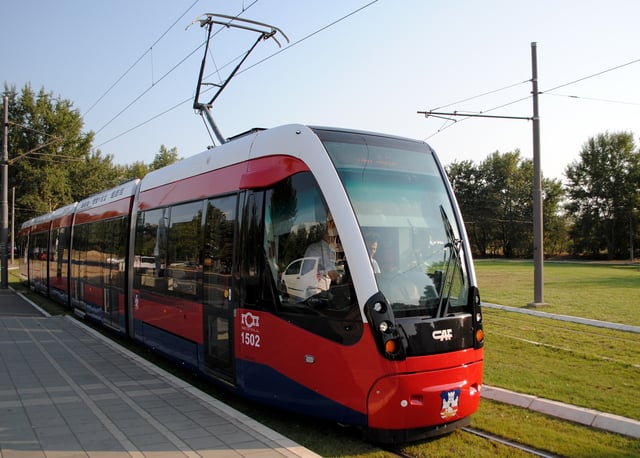
GSP Belgrade Urbos 3 tram
In 2011, GSP Belgrade began with the acquisition of new Urbos 3 trams from the Spanish manufacturer CAF. By the end of 2012, it was planned to supply 30 trams of this model. The new trams are commonly referred to as Španac (Spaniard) by Belgrade's residents.
GSP Belgrade introduced BusPlus on 1 February 2012. BusPlus is an electronic payment method where commuters load fares on a thin plastic card.[6] Also, the private carriers were introduced and integrated in tariff system – Integrated Tariff System (ITS).[7] There are 145 lines, out of which 12 are tram, 8 are trolleybus and 125 are bus lines. Service operates daily between 4 am and midnight, with a limited night bus system. GSP also operates school bus lines, and transportation for the disabled. The entire traffic grid is divided in two zones.
In April 2019, GSP along with the city of Belgrade signed a contract to purchase 244 new buses, of which 70 are manufactured by Turkish BMC and 174 by Chinese Higer.[10]
Vehicle coloring
Until the beginning of the 1960s, the vehicles have been colored by cream and red color scheme (buses have been colored until 1961. trolleybuses and trams are colored until 1964). From the beginning of the 1960s, the vehicles have been colored by Mussolini livery – light and dark green color scheme (for buses from 1961 to 1967, for trolleybuses and trams from 1964 to 1970).
From the end of the 1960s, the vehicles have been colored by cream and green color scheme (for trams and trolleybuses from 1970 to 1979, for buses from 1967 to 1987). From the end of the 1970s, the vehicles have been colored by cream and red color scheme again (for trams and trolleybuses from 1979 to 2003, for buses from 1987 to 2004).
From the beginning of 2000s, the vehicles are coloring by three color schemes with blue bottom (trams are colored by red and blue color scheme from 2002, trolleybuses are colored by orange and blue color scheme from 2003 (for some units, but their current color scheme is red from 2010), and buses are colored by yellow and blue color scheme from 2004 (in future, their color scheme will be red from 2015)). Some vehicles have been colored by cream and blue color scheme (like the private buses in the end of the 1990s, for example: one trolleybus ZiU-9 and one tram ČKD-Tatra KT4YU have been colored in cream and blue color scheme in 1993 (in collaboration with Mašinska Industrija Niš - MIN), and two trams ČKD-Tatra KT4YU have been coloured in cream and blue colour scheme in 2001).
Vehicle fleet
Current fleet
Buses

Most of the GSP bus fleet consists of domestic Ikarbus models, mainly IK-201 articulated bus.
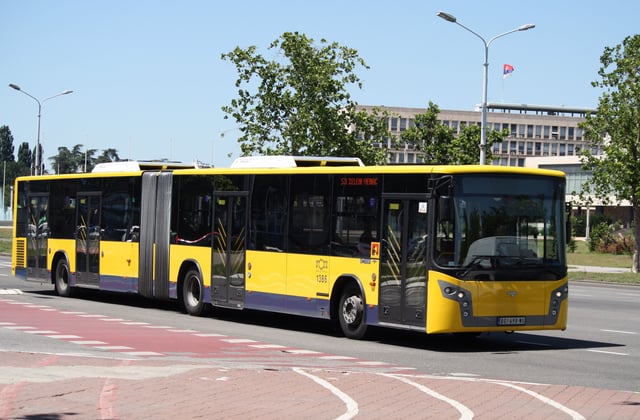
IK-218M are the latest model made by Ikarbus.
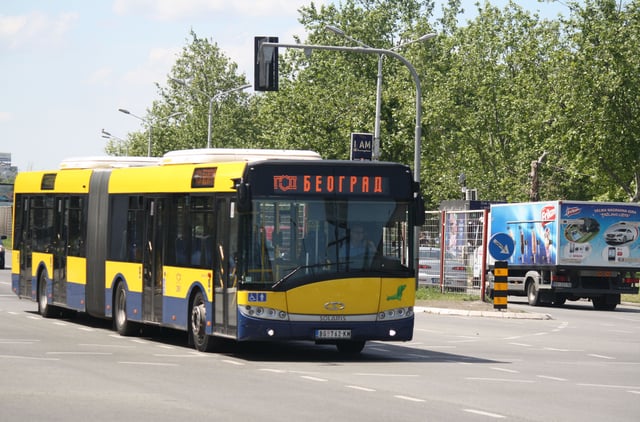
200 Solaris Urbino 18 were purchased as major modernization of GSP bus fleet.
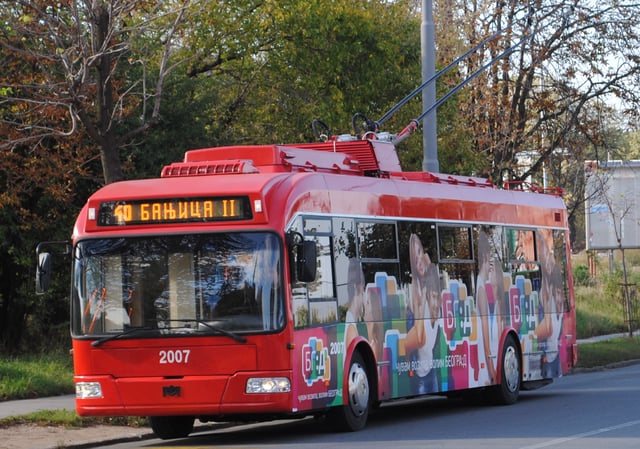
The GSP trolleybus fleet is the youngest, most consisting of Belkommunmash models AKSM-321 and AKSM-333 (from 2010).
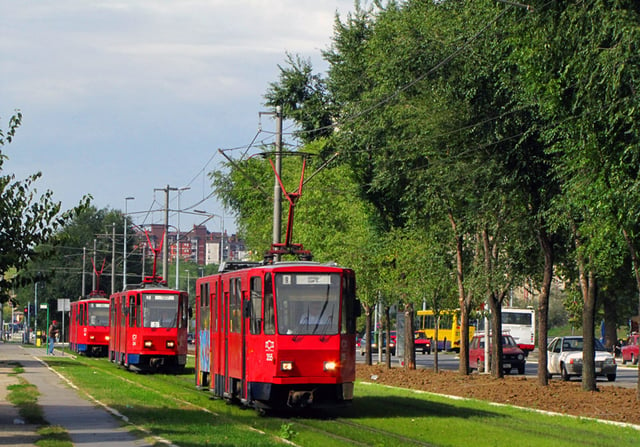
ČKD Tatra KT4 trams.
BMC Procity 12 – solo
Ikarbus IK-101 (from 1997) – solo IK-103 (from 1998) – solo IK-106 (from 1997) – solo IK-111 (from 1985) – solo IK-112.3 (from 2006) – solo IK-112N (from 2008) – solo IK-201 (from 1997) – articulated IK-202 (from 1998) – articulated IK-203 (from 1999) – articulated IK-218 (from 2011) – articulated IK-218.3 (from 2007) – articulated IK-218N (from 2009) – articulated IK-218M (from 2012) – articulated
Fabrika automobila Priboj FAP A-537 (from 2000) – solo
Karosa В932 – donation from Czech Republic (from 2000) – solo
MAZ/BIK BIK-203 CNG (from 2010) – solo
Solaris Urbino 18 (from 2013) – articulated
Trolleybuses
ZiU/TrolZa ZiU-682G (from 1989) – solo TrolZa-62052.01 (from 2000) – articulated
Belkommunmash AKSM-201.01 (from 2001) – solo AKSM-321.00S (from 2005) – solo AKSM-333.04 (from 2004) – articulated
Trams
ČKD Tatra Tatra KT4YUB/YUBM (from 1980) – articulated
Düwag GT6 (Be 4/6) – donation from Basel (Switzerland) (from 2001) – articulated
CAF Urbos 3 (from 2011) – low floor articulated
Unique trams Čičica – originally remaining Đuro Đaković TMK 101 (from 1994) – solo ČKD T4D – donation from Halle (Germany) (from 2002) – solo SWP Be 4/4 – donation from Basel (Switzerland) (from 2001) – solo
Vehicles used in the past
Buses
Past buses Mercedes-Benz O317K FAS "11 Oktomvri" Skoplje (1973–1990) – solo – 17 years Mercedes-Benz O305G (2000–2003) – donation from Germany – articulated – 3 years Mercedes-Benz O405G (2000–2012) – donation from Germany – articulated – 12 years FAS-Sanos S115 (1985–2013) – solo – 28 years FAS-Sanos S200 (2000–2003) – donation from Ljubljana (Slovenia) – articulated – 3 years MAN Avtomontaža 890 UO (1974–1986) – solo – 12 years MAN Avtomontaža 890 UG (1970–1981) – articulated – 11 years MAN 890 UO Ikarus Zemun IK-6B (1969–1987) – solo – 18 years MAN 890 UG Ikarus Zemun IK-5B (1975–1994) – articulated – 19 years MAN Avtomontaža SU 220 (1981–2008) – solo – 27 years MAN Avtomontaža SG 220 (1987–2003) – articulated – 16 years Ikarus IK-4B (1971–1990) – solo – 19 years Ikarus IK-105B (1982–2000) – solo – 18 years Ikarus IK-102 (1988–2014) – solo – 26 years Ikarus IK-110B (1984–2013) – solo – 29 years Ikarus IK-111 (1990–2000) – donation from Timisoara (Romania) – solo – 10 years Ikarus IK-160B (1985–2013) – articulated – 28 years Ikarus IK-161 (1986–2014) – articulated – 28 years Ikarus IK-166 (1991–2014) – articulated – 23 years Ikarus IK-166 (1994–2013) – donation from Istanbul (Turkey) – articulated – 19 years Ikarus IK-167 (1990–2003) – articulated – 13 years FAP-Leyland Kokarus (1963–1982) – solo – 19 years FAP G100 (1965–1981) – solo – 16 years FAP G160 (1967–1980) – articulated – 13 years TAM AS 3500 (1968–1981) – solo – 13 years Leyland Worldmaster (1961–1977) – solo – 16 years MAN NL 312 (2000–2012) – donation from Germany – solo – 12 years Fiat Iveco (2000–2009) – donation from Trieste (Italy) – solo – 9 years Graf-Stift GU 230 (2000–2004) – donation from Austria – articulated – 4 years Ikarus 260 (2000–2002) – donation from Greece – solo – 2 years
Trolleybuses
Past trolleybuses Alfa Romeo / Goša (1962–1984) – solo – 22 years Goša Fages (1956–1981) – solo – 25 years Goša Prototype (1987–1995) – solo – 8 years Fiat CGE (1949–1980) – solo – 31 years Tatra T400 (1947–1961) – solo – 14 years ZiU 9 (1979–2012) – solo – 33 years ZiU 682B-10 (2005–2010) – donation from Athens (Greece) – solo – 5 years Trolza 5275-05 (2003–2010) – solo – 7 years VMZ 5298(375) (2000–2010) – solo – 10 years Graf-Stift OE112 M11 (2001–2007) – donation from Austria – solo – 6 years Graf-Stift OE112 M16 (2001–2010) – donation from Austria – articulated – 9 years
Trams
Past trams Đuro Đaković TMK 101 (1964–1980) – solo – 16 years Đuro Đaković TMK 201 Prototype (1967–1983) – solo – 16 years Đuro Đaković TMK 201 (1970–1991) – solo – 21 years ČKD Tatra T4D Prototype (1967–1983) – solo – 16 years ČKD Tatra T4YUB (1972–1991) – solo – 19 years Breda I (1940–1970) – solo – 30 years Breda II (1949–1974) – solo – 25 years Breda III 5300 (1960–1985) – solo – 25 years PCC I (700) – from Belgium (1952–1981) – solo – 29 years PCC II (B6) – from Belgium (1960–1985) – solo – 25 years Jasenica – from Goša or Đuro Đaković (1936–1980) – solo – 44 years DUEWAG T4 – Hagen (1977–1986) – solo (bi-directional) – 9 years DUEWAG GT6 – Hagen (1978–1987) – articulated (bi-directional) – 9 years Goša (1956–1968) – solo – 12 years MAN-Siemens Shuckert (1923–1960) – solo – 37 years AEG (1923–1971) – solo – 48 years Škoda / Kolben Ringhofer (1927–1967) – solo – 40 years BBC – Brown, Boveri & Cie (1927–1964) – solo – 37 years